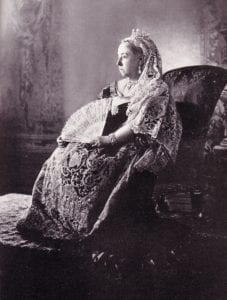N. Reece Ho-Sheffield
Singapore

King George III in coronation robes. Allan Ramsay. Circa 1765. Art Gallery of South Australia. Accessed via Wikimedia Commons. Public Domain.
Famous people with genetic disorders have always been a subject of interest, and royalty are often considered the crème de la crème of celebrities. Any medical condition may give some insight into their lives and provide an explanation for a physical feature or behavior.
Two genetic blood diseases plagued the European Royals. The porphyrias are a group of inherited disorders associated with the production of heme, an iron-containing compound used to make hemoglobin in red blood cells. In each type of porphyria, one of the enzymes that controls heme biosynthesis is lacking, leading to a buildup of porphyrins in the body and causing symptoms such as abdominal pain, nervous system manifestations, mental health issues, and skin eruptions.
The “royal” porphyria is porphyria variegata, which has an incidence in the general population of 1 in 100,000. It is due to a deficiency in the enzyme protoporphyrinogen oxidase (PPOX). Most inborn errors of metabolism are inherited as autosomal recessive, but this disorder is inherited as autosomal dominant with low penetrance. Porphyria variegata does not “skip a generation,” but those with the gene have such variable manifestations that some are labeled as “silent carriers.” The gene called PPOX has been mapped and cloned to chromosome 1q.1 During an acute attack, urinary levels of porphobilinogen and delta-aminolevulinic acid and fecal levels of protoporphyrin and coproporphyrin are elevated.2,3
King George III reigned from 1738-1820. He presided over a turbulent period of British history that saw the American War of Independence, the French Revolution, the Irish Rebellion, and the Catholic Emancipation. When George III was between fifty to seventy years of age, he suffered a series of incapacitating bouts of “madness.” During each attack, attending physicians noted a rapid pulse, fever, a yellowish discoloration of the eyes, abdominal colic, constipation, cramps in the legs, skin blistering on the arms, port wine-colored urine, and rambling and incessant speech that degenerated into obscenities and hallucinations.4 At that time, speculative diagnoses were profuse, from “bilious attacks” to gout to sheer insanity. Treatments ranged from emetics and cathartics to straightjacket confinement and blood-letting with leeches. Just as each episode was acute in onset, so recovery was equally sudden and rapid. In 1810 George III had a relapse, after which he descended into permanent derangement. Deemed to be mad and too confused to rule, he died an octogenarian in custodial care in 1820.5,6
These clinical features are consistent with a diagnosis of variegate porphyria, and may be traced back to his ancestors Mary Queen of Scots in the 1500s, and her son, King James I.7,8 With King James I (of the King James’ version of the Holy Bible), his meticulous physician Sir Theodore Turquet de Mayerne recorded abdominal colic, diarrhea, yellow discoloration of the eyes, leg cramps, increased sensitivity to sunlight with blistering of the skin, and urine “red like Alicante wine.” Lady Arbella Stuart, a first cousin of King James I, was also reported to have all the tell-tale manifestations of porphyria variegata.8 The genetic source of origin may have been the affected Queen Margaret Tudor, the great-grandmother of King James I and Lady Arbella Stuart.
George III’s illness was intermittent and short-lived until his final days, but these episodes did throw the British Constitution into crisis. With his life depicted as a tragicomedy, he was dubbed “The Mad King George” in plays and movies. His highly controversial politics, certainly not helped by his disorder, had always overshadowed his more sterling qualities of affection and fidelity to his Queen, love for his children, and intellectual curiosity in music, literature, art, agriculture, and architecture.4,5
George III’s granddaughter was Queen Victoria. Queen Victoria’s eldest daughter “Vicky” and her daughter, Princess Charlotte of Prussia, suffered from porphyria. Charlotte of Prussia complained of excruciating pains that wandered around her body, being lame, having blisters all over her face, and passing dark red urine. DNA tests performed on Charlotte’s remains revealed a mutation in the gene PPOX, confirming the diagnosis of variegate porphyria.9
Queen Victoria’s grandson was King George V, who had five sons including King George VI (father of Queen Elizabeth II) and Prince Henry (Duke of Gloucester). King George V was married to his second-cousin-once-removed Princess Mary of Teck, who herself was a great-granddaugher of King George III. Prince Henry’s elder son, William of Gloucester, a first cousin of the Queen, died in a plane crash in 1972 at the age of thirty-one. The deceased Prince William was diagnosed with certainty by specialists in Addenbrookes Hospital, Cambridge to have porphyria variegata, having displayed many of its classical manifestations.10

Hemophilia A, labeled the “royal disease,” is inherited as an X-linked recessive, with an incidence of 1 in 5,000 male live births. It is due to a deficiency of factor VIII, a protein coagulant that plays a vital role in the blood clotting pathway.11,12 About one-third of affected males are new mutations, meaning the alteration in the gene occurs for the first time in them; hence there is no antecedent family history of the disorder. Hemophilia A is characterized by easy bruising, prolonged bleeding, and hemorrhaging into joints, muscles, and other tissues including the brain. The gene for hemophilia A has been mapped and cloned to Xq28. Carrier detection is possible and replacement therapy with factor VIII is effective.11
Alexandrina Victoria was the granddaughter of George III. Credit was given to Queen Victoria for perpetuating the British Monarchy during a volatile period that witnessed the collapse of several European thrones.13 But she also received notoriety for passing on a mutated gene on her X chromosome that inadvertently initiated the malady of hemophilia A in the royal houses of Britain, Russia, Prussia, and Spain.14
Queen Victoria and Prince Albert had nine children.15 Leopold, her fourth son, was the first to show signs of hemophilia A. His inclination to bleed profusely from minor trauma and “near death” experiences gave much reason for alarm. Following a fall, he died at the age of thirty-one from a brain hemorrhage. Before his demise, he sired two children; a son who was unaffected (because he had inherited his father’s Y chromosome), and a daughter, Alice of Athlone, who inescapably was a carrier (because she had inherited her father’s defective X chromosome). Alice of Athlone’s son, Rupert, was afflicted with hemophilia and died of cerebral hemorrhage.14,16
Queen Victoria’s daughters, Princess Alice and Princess Beatrice, were undoubtedly carriers. Their sons showed signs of the disorder, reaffirming that Queen Victoria was an obligate carrier and indicating the mutation in the affected gene first occurred in her germline, since there were no records of ancestors or relatives in her generation being affected.14
Princess Alice wedded the Duke of Hesse. Her affected son “Frittie” died young following a brain hemorrhage, while two of her daughters, Alix and Irene, were carriers.
Irene married Prince Henry of Prussia and introduced the mutant gene to the royal house of Prussia. The disease appeared in two of their sons, Princes Waldemar and Henry. Waldemar died during World War II due to a lack of blood transfusion facilities. Four-year-old Henry succumbed following a fall.
Empress Alexandra, “Alix” wedded Tsar Nicholas II of Russia and spread the mutant allele to the Romanov royal family. After four daughters, she gave birth to their one son, Tsarevich Alexis, heir to the Russian Empire. He was stricken with hemophilia. During the ensuing Russian Revolution, the entire Romanov family perished following their brutal murder at the hands of a Bolshevik firing squad in 1918. It was then thought that the mutant gene might have terminated in the Russian royal house.14,16
Queen Victoria’s other daughter, Beatrice, had two affected sons, Leopold Mountbatten and Maurice, and one carrier daughter, Eugenie. Leopold Mountbatten died following a hip operation, while Maurice was killed during World War I. Eugenie married King Alfonso XIII of Spain, propagating the gene in the Spanish royal house. They produced two affected sons, Alfonso who was the heir to Spain, and Gonzalo. Both young Alfonso and Gonzalo were dressed in padded suits to prevent fatal knocks. Notwithstanding, both perished in a fatal car crash with uncontrollable internal bleeding. Eugenie and King Alfonso XIII’s daughter Beatriz was most likely a carrier, for Beatriz’s daughter Olimpia had a son who died of a bleeding disorder.16
Was Queen Victoria’s governmental constitution ever in crisis over the hemophilia issue? The answer is no. Nonetheless, she wrote in her diary about her personal life, “Our poor family seems so persecuted by this awful disease. . . .”
It is remarkable how this mutant X chromosome of Queen Victoria could wreak such havoc on so many royals. To date, the last known affected descendant of Queen Victoria was Waldemar of Prussia, who died in 1945. Olimpia, from the Spanish royal house, may be the last surviving carrier, for her child, Paul Alexander, died of a bleeding disorder. It is possible that the defective allele has gone into extinction, or it may exist in a “quiescent stage” of the carrier state of Victoria’s female lineage, only for the disorder to resurface in her more distant male descendants.
References
- Meissner PN, Dailey TA, Hift RJ et al. A R59W mutation in human protoporphyrinogen oxidase results in decreased enzyme activity and is prevalent in South Africans with variegate porphyria. Nat Genet 13:95-97; 1996.
- Dean G. The porphyrias: a story of inheritance and environment. 2nd edition. Philadelphia: J.B. Lippincott; 1972.
- Mustajoki P. Variegate porphyria. Ann Intern Med 89:238-244; 1978.
- Ayling S. George the Third. New York: Alfred A. Knopf; 1972.
- Ashley M. The mammoth book of British kings and queens. New York: Carroll and Graf; 1998.
- Cannon J, Griffiths R. Oxford illustrated history of the British monarchy. Oxford: Oxford University Press; 1998.
- Macalpine I, Hunter R, Rimington C. Porphyria in the royal houses of Stuart, Hanover and Prussia: a follow-up study of George III’s illness. Br Med J 1:7-18; 1968.
- Steen SJ. The letters of Lady Arbella Stuart. New York: Oxford University Press; 1994.
- Wilson AN. Victoria: A Life. Penguin Press; 2015.
- St. Aubyn G. William of Gloucester: Pioneer Prince. London: Frederick Muller; 1977.
- Mannucci PM, Tuddenham EGD. The hemophilias-from royal genes to gene therapy. N Engl J Med 344:1773-1779; 2001.
- Tuddenham EGD, Cooper DN. The molecular genetics of homeostasis and its inherited disorders. Oxford: Oxford University Press; 1994.
- Weintraub S. Victoria: an intimate biography. New York: Truman Talley Books; 1987.
- McKusick VA. The royal hemophilia. Sci Am 213:88-95; 1965.
- Hough R. Victoria and Albert. New York: St. Martin’s Press; 1996.
- Stevens RF. The history of haemophilia in the royal families of Europe. Br J Haemat 105:25-32; 1999.
N. REECE HO-SHEFFIELD, MD, graduated and practiced clinically in the United Kingdom for numerous years before moving to the United States to pursue medical research in genetic disorders in the National Institutes of Health, Maryland. She was an Assistant Professor in Pediatrics, Johns Hopkins University School of Medicine, Maryland, USA. She specialized in Pediatrics and Medical Genetics.
Submitted for the 2019–2020 Blood Writing Contest

Leave a Reply